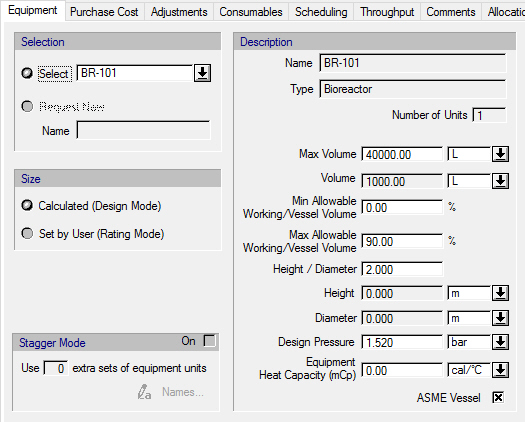

The following table shows the meaning of the variables appearing in this tab, as well as their default values and their generally acceptable range. Note that due to the manner by which the variables are used by the sizing and costing equations, the range of acceptable values may be further reduced.
|
Variable |
Default Value |
Range |
|
|
||
|
◙ Volume |
1,000.0 L |
Positive |
|
◙ Max Volume |
40,000 L |
Positive |
|
○ Min Allowable Working/Vessel Volume |
0% |
[0,99] |
|
○ Max Allowable Working/Vessel Volume |
90% |
(0,99] |
|
● Height |
0 m |
Positive |
|
● Diameter |
0 m |
Positive |
|
○ Height/Diameter |
2.0 |
Positive |
|
○ Design Pressure |
1.52 bar |
Positive |
|
○ Equipment Heat Capacity (mCp) |
0 kcal/°C |
Positive. |
|
○ Is ASME Vessel? |
Yes |
Yes/No |
Symbol Key: ○ User-specified value (always input); ● Calculated value (always output); ◙ Sometimes input, sometimes output
In design mode, the user specifies the max volume, and the program calculates the number of units and volume based on the volume demand that is specified by the operations carried out as part of the (one or more) unit procedures hosted by the equipment resource. Typically, even during the span of a single procedure, more than one operations may demand different volumes. The software will size the vessel based on the largest demand on vessel volume amongst all operations executed in the vessel. If that volume exceeds the maximum volume specification then the software will assume multiple number of identical units, each with a volume that does not exceed the max volume specification. From the vessel volume and the height-diameter aspect ratio, the actual dimensions of each vessel (height and diameter) are calculated.
Depending on the unit procedure’s nature (batch vs continuous), the demand on vessel volume by each operation is calculated as follows: If the unit procedure is batch (e.g., Batch Vessel Procedure in a Reactor), then for each operation the demand on liquid volume is divided by the operation’s max allowable working to vessel volume ratio to determine the operation’s demand on vessel volume. In that case, the equipment’s min and max allowable working to vessel volume ratio limits act as constraints on the operation’s min and max allowable working to vessel volume ratio limits (i.e., the operation’s min and max working to vessel volume ratio limits must be within the range defined by the equipment’s min and max working to vessel volume ratio limits). If the unit procedure is continuous (e.g., Continuous Stoichiometric Reaction in a CSTR), then for each operation the demand on liquid volume is divided by the operation’s working to vessel volume ratio to determine the operation’s demand on vessel volume. In that case, the equipment’s min and max allowable working to vessel volume ratio limits act as constraints on the operation’s working to vessel volume ratio (i.e., the operation’s working to vessel volume ratio must be within the range defined by the equipment’s min and max working to vessel volume ratio limits).
In rating mode, the volume of the vessel and the number of units are provided by the user. As in the design mode case, the actual dimensions of each vessel (height and diameter) are calculated from the vessel volume and the height-diameter aspect ratio. The program also calculates exactly as in the design mode case the demand on vessel volume by the operations carried out as part of the unit procedure(s) hosted by the equipment resource, and if any operation’s vessel volume demand of exceeds the actual vessel volume, it generates an error.
The equipment purchase cost is based on the total vessel volume. It includes cost of the agitator and it is supplied by the built-in model assuming as material of construction SS316. Other factors that affect the cost are:
● Conforming to ASME Specification; if checked, then the vessel is assumed to have been constructed according to standards published by the American Society of Mechanical Engineers (ASME) and it is assumed to withstand pressure up to 35psig. Checking this option penalizes the cost by about 20% over the base cost.
● Design Pressure; vessels required to withstand pressures above 3 atm are penalized by about 80% over base cost.
● Equipment Heat Capacity; the product of equipment mass times its specific heat capacity. It is used by operations that are executed in the vessel and involve heating and/or cooling. If part of the heat exchange is directed to the vessel, then this variable is used to estimate heating/cooling losses.
For more information on this equipment, see:
● Silo
For information on the left-hand side variables and options, see Equipment Data Dialog: Equipment tab.